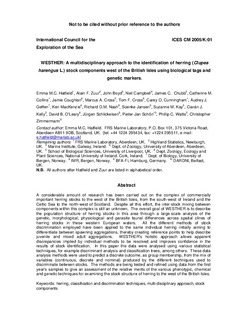WESTHER: A multidisciplinary approach to the identification of herring (Clupea harengus L.) stock components west of the British Isles using biological tags and genetic markers.
| dc.contributor.author | Hatfield, Emma M. C. | |
| dc.contributor.author | Zuur, Alain F. | |
| dc.contributor.author | Boyd, John | |
| dc.contributor.author | Campbell, Neil | |
| dc.contributor.author | Chubb, James C. | |
| dc.contributor.author | Collins, Catherine M. | |
| dc.contributor.author | Coughlan, Jamie | |
| dc.contributor.author | Cross, Marcus A. | |
| dc.contributor.author | Cross, Tom F. | |
| dc.contributor.author | Cunningham, Carey O. | |
| dc.contributor.author | Geffen, Audrey J. | |
| dc.contributor.author | MacKenzie, K. | |
| dc.contributor.author | Nash, Richard D.M. | |
| dc.contributor.author | Jansen, Soenke | |
| dc.contributor.author | Kay, Suzanne M. | |
| dc.contributor.author | Kelly, Ciarán J. | |
| dc.contributor.author | O'Leary, David B. | |
| dc.contributor.author | Schlickeisen, Jürgen | |
| dc.contributor.author | Schön, Pieter-Jan | |
| dc.contributor.author | Watts, Phillip C. | |
| dc.contributor.author | Zimmermann, Christopher | |
| dc.date.accessioned | 2012-02-07T09:10:54Z | |
| dc.date.available | 2012-02-07T09:10:54Z | |
| dc.date.issued | 2005 | |
| dc.identifier.citation | This report is not to be quoted without prior consultation with the General Secretary. | no_NO |
| dc.identifier.uri | http://hdl.handle.net/11250/103710 | |
| dc.description.abstract | A considerable amount of research has been carried out on the complex of commercially important herring stocks to the west of the British Isles, from the south-west of Ireland and the Celtic Sea to the north-west of Scotland. Despite all this effort, the inter-stock mixing between components within this complex is still an unknown. The overall goal of WESTHER is to describe the population structure of herring stocks in this area through a large-scale analysis of the genetic, morphological, physiological and parasite faunal differences across spatial clines of herring stocks in these western European waters. All the different methods of stock discrimination employed have been applied to the same individual herring initially aiming to differentiate between spawning aggregations, thereby creating reference points to help describe juvenile and mixed adult aggregations. WESTHER's holistic approach allows apparent discrepancies implied by individual methods to be resolved and improves confidence in the results of stock identification. In this paper the data were analysed using various statistical techniques, for example discriminant analysis and classification trees, among others. These data analysis methods were used to predict a discrete outcome, as group membership, from the mix of variables (continuous, discrete and nominal) produced by the different techniques used to discriminate between stocks. The methods are being tested and refined using data from the first year's samples to give an assessment of the relative merits of the various phenotypic, chemical and genetic techniques for examining the stock structure of herring to the west of the British Isles. Keywords: herring, classification and discrimination techniques, multi-disciplinary approach, stock components | no_NO |
| dc.language.iso | eng | no_NO |
| dc.publisher | ICES | no_NO |
| dc.relation.ispartofseries | ICES CM documents;2005/K:01 | |
| dc.subject | herring | no_NO |
| dc.subject | sild | no_NO |
| dc.subject | fisheries research | no_NO |
| dc.subject | fiskeriforskning | no_NO |
| dc.title | WESTHER: A multidisciplinary approach to the identification of herring (Clupea harengus L.) stock components west of the British Isles using biological tags and genetic markers. | no_NO |
| dc.type | Working paper | no_NO |
| dc.subject.nsi | VDP::Agriculture and fishery disciplines: 900::Fisheries science: 920::Resource biology: 921 | no_NO |
| dc.source.pagenumber | 18 s. | no_NO |
Tilhørende fil(er)
Denne innførselen finnes i følgende samling(er)
-
ICES CM documents authored by IMR scientists (1949-2011) [3138]
Includes a few working documents.
